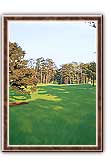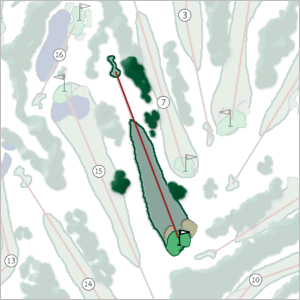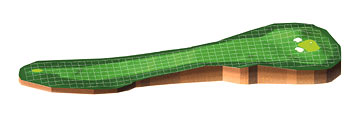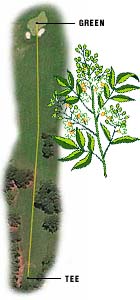| Hole Names | |
|
|
|

Hole #17NandinaNandia domestica Par 4, 425 Yards |

|
||
|
A welcome respite after water holes on the second nine, this par 4 features one of the wider fairways. The Eisenhower Tree stands left-center of the fairway approximately 190 yards from the tee. The former President of the US and Club member hit into the tree so often he campaigned to have it removed. Tee box moved back 25 yards, making the Eisenhower tree come into play. Only choice is a draw around the tree or a low tee shot under it. Landing area is uphill. Green fronted by two bunkers and has a slight crown that makes it difficult to hold. The Eisenhower Pine is left-center of the fairway about 195 yards from the tee, forcing a right-to-left shape off the tee. Green is fronted by two bunkers and has a slight crown that makes it difficult to hold. A large ever-growing tree, the Eisenhower Pine, stands sentinel on the left side of the fairway. The green slopes off toward the back, making it nearly impossible to hold an approach carried past the center of the green. | |||

QuickTime AVI (4.28M) Animated GIF | |||
|
Jack Nicklaus says: I think here, most of the fellows hit it hard to be able to play a short iron into the green. Probably looks like the easiest hole on the golf course, but causes a lot of problems. A good drive should leave you with a 7-, 8- or 9-under into the green. There really isn't any pin position that is protected that much, so if you hit a solid shot you should have a chance for a three. I missed about a three-footer for birdie here in the final round in 1966 and when I saw the replay afterward, I noticed that my head was out over the ball on my putt. I went to the practice green and putted until it was almost dark. The next day, I won a playoff with Tommy Jacobs and Gay Brewer. This hole was also important in 1986 when I birdied it from off the fairway. Watching the putt drop remains one of the most memorable moments of my careeer. Changes in 1998 made this hole much more demanding. In fact, it ranked third in difficulty, behind only No. 4 (first) and No. 12 (second). With the tee moved back some 25 yards, the 17th requires a big tee shot. The large pine that President Eisenhower campaigned to have removed can come into play. Last year, Jose Maria Olazabalís tee shot Sunday went through the branches of that famous pine and he had to scramble for a much-needed par. This green is far more receptive to an 8- or 9-iron than it is to a 5-iron. You can shoot for the flag, but you canít go long or too far left when the pin is on the right. Itís next to impossible to get it down in regulation from back there. Fuzzy Zoeller says: It's an uphill drive, and it's preferable to be in the right-center of the fairway. It's just a 7 iron to a pitching wedge to the green; not a demanding hole. The green slopes right to left, but because of the grain it doesn't break as much. You do have to watch the speed of your putt. Tiger Woods says: I normally hit 3-wood or driver, depending on the wind. You cannot go long; anything long is a definite bogey. Anything right is probably the same. You've got to try and hit the ball in the middle of the green, and below the hole. Four is a good score. Fred Couples says: This is probably the easiest hole on the course. There are a couple of fir trees in the fairway that a guy who hits it high and long just shoots it right up over them. Then you can hit anything from an 8-iron to a sand wedge to a green that is fairly easy, except for a Sunday pin when they put it up on this little crown. Bernhard Langer says: My birdie here on Sunday in 1985 was memorable not so much because it gave me a two-shot lead, but because my playing partner, Seve Ballesteros, tapped me on the shoulder after I made the birdie putt and said, "You deserve this one." I thought that was a nice gesture. The temptation is to relax on No. 17 after two tough water holes, but I've learned over the years that you can make bogey here pretty quickly. That possibility is even stronger now that the club has moved the tee back about 25 yards this year. Players will have to hit out of a narrower chute and the Eisenhower Tree, even though it's only 200 yards away, may come into play. We're also going to get less run off the tee shot because it may hit the upslope. The ideal drive has a little draw because the trees hanging over the tee don't allow a fade. From that upslope in the fairway, it's not possible to see the whole green, or for that matter, much of the flag, making good club selection critical. The green's right side has a pretty severe slope, so the safest spot appears to be the center of the green. It's not easy to get it there, though.
| |||

Hole #17NandinaNandia domestica Nandina domestica, sometimes called Heavenly Bamboo, is an oriental shrub. Often located near the doors of Japanese homes, it is a good luck symbol which is supposed to mediate family disputes. The foliage shows varying degrees of color ranging from copper to green to red. With its white blooms in May and spectacular red berries from fall to winter, the Nandina can show varying colors year round. |

|
||
fatpat Software · PO Box 1785 · Charlottesville, VA 22902 · (804) 977-1652
